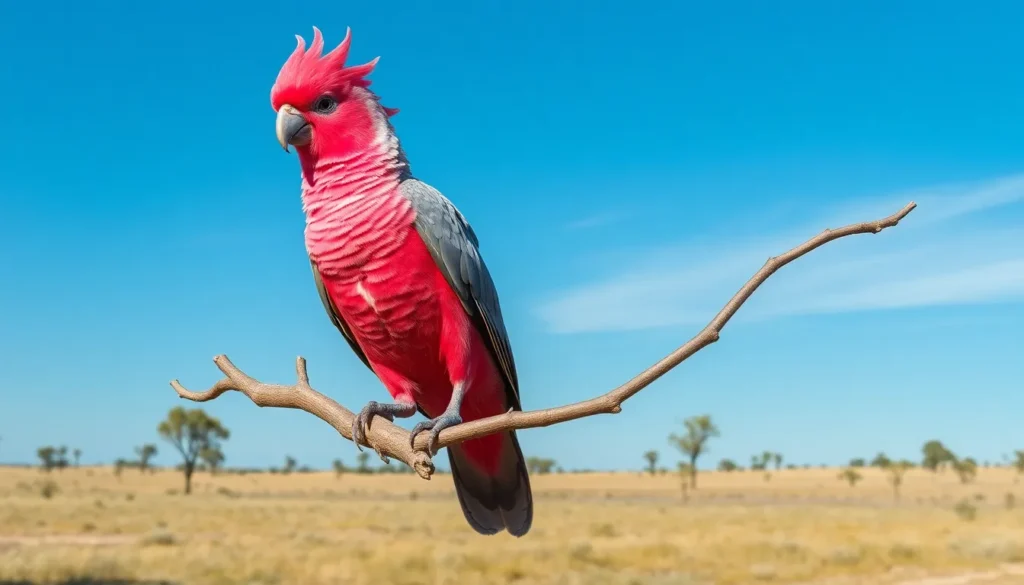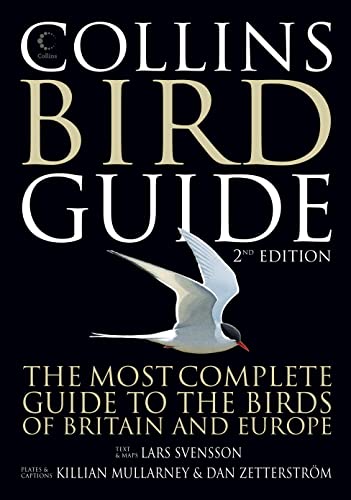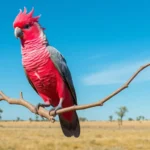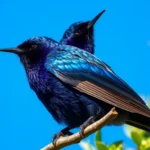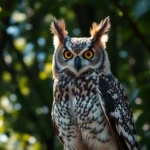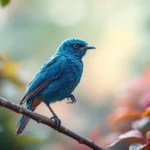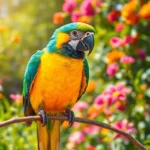We’ve all encountered those vibrant pink and grey parrots that seem to steal the show wherever they appear. Galahs – Australia’s most beloved and recognizable cockatoos – captivate bird enthusiasts worldwide with their playful antics and striking appearance.
These intelligent birds aren’t just pretty faces in the avian industry. We’re talking about creatures that display remarkable social behaviors, impressive problem-solving skills, and an almost human-like capacity for mischief. From their distinctive rose-colored chest feathers to their acrobatic flight patterns, galahs have earned their reputation as Australia’s most charismatic parrots.
Whether you’re a seasoned birdwatcher or simply curious about these fascinating creatures, understanding galah behavior and characteristics opens up a window into one of nature’s most entertaining species. We’ll explore everything that makes these pink-crested comedians so special in the wild Australian industry.
What Is a Galah Bird?
Galahs represent one of Australia’s most recognizable cockatoo species, scientifically known as Eolophus roseicapilla. These distinctive parrots combine striking coloration with remarkable intelligence, making them standout members of the cockatoo family.
Physical Characteristics and Appearance
Galah birds display a stunning pink and grey color scheme that sets them apart from other Australian parrots. The chest, belly, and underwings showcase vibrant rose pink feathers, while the back, wings, and tail feature soft grey plumage. Their heads present the same rosy pink coloration as their underparts, creating a balanced and eye-catching appearance.
Both male and female galahs possess similar coloring, though subtle differences exist in their eye colors. Males typically have dark brown or black eyes, while females display reddish-brown irises. Their beaks appear pale grey to horn-colored, perfectly complementing their overall coloration.
Galah birds feature prominent crests that they raise and lower to express emotions and communicate with other birds. The crest feathers match the pink coloration of their heads, adding to their expressive capabilities. Their feet and legs appear dark grey to black, providing strong grips for perching and climbing.
Size and Wingspan Details
| Measurement | Range |
|---|---|
| Body Length | 14-16 inches (35-40 cm) |
| Wingspan | 24-28 inches (60-70 cm) |
| Weight | 10-14 ounces (280-400 grams) |
Galahs rank as medium-sized cockatoos within the parrot family structure. Adult birds reach lengths between 14 to 16 inches from head to tail, making them smaller than Sulphur-crested Cockatoos but larger than Cockatiels. Their wingspan extends 24 to 28 inches when fully spread, allowing for efficient flight across Australia’s vast landscapes.
Weight variations occur between individual birds, with healthy adults weighing 10 to 14 ounces. Females often weigh slightly less than males, though the difference remains minimal. These proportions give galahs excellent maneuverability during flight while maintaining the robust build characteristic of cockatoo species.
Natural Habitat and Distribution
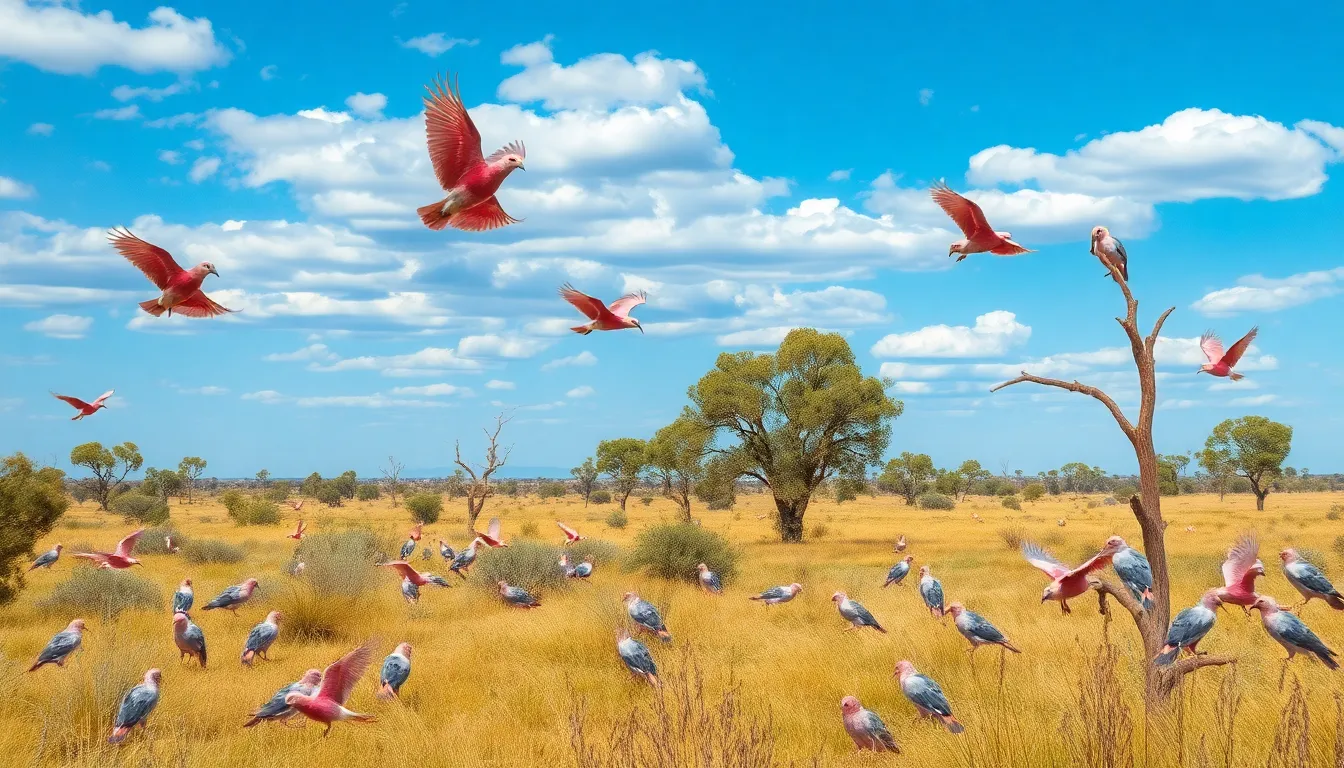
Galahs occupy diverse landscapes across mainland Australia, establishing themselves as one of the continent’s most widespread cockatoo species. Their remarkable adaptability allows these pink and grey birds to thrive in environments ranging from arid outback regions to urban parks.
Where Galahs Live in the Wild
Australia’s entire mainland serves as home to galah populations, with the species absent only from Tasmania and some offshore islands. Dense forests and rainforests represent the primary environments galahs avoid, preferring open spaces that accommodate their foraging behaviors and flight patterns.
Woodlands provide ideal galah habitat, particularly areas featuring scattered eucalyptus trees that offer both nesting sites and food sources. Grasslands attract large flocks during feeding times, where these birds consume seeds from native grasses and herbs. Agricultural areas have become increasingly important to galah populations, with crop fields supplying abundant food resources throughout different seasons.
Urban environments support thriving galah communities, especially in cities like Adelaide, Perth, and Melbourne where parks and gardens create suitable habitat corridors. Suburban areas with mature trees and open spaces often host permanent galah residents year round.
Preferred Environmental Conditions
Temperature ranges between 60°F and 85°F create optimal conditions for galah activity, though these adaptable birds tolerate much broader temperature variations across Australia’s climate zones. Rainfall patterns significantly influence galah distribution, with populations concentrating in areas receiving 8 to 20 inches of annual precipitation.
Elevation preferences keep most galah populations below 3,280 feet, though some communities establish territories at higher altitudes in mountainous regions. Coastal areas attract galahs when inland water sources become scarce during drought periods.
Water accessibility within 6 miles of roosting sites determines habitat suitability, as galahs require daily access to fresh water sources. Rivers, lakes, farm dams, and even swimming pools provide essential hydration points that anchor galah territories.
Open flight corridors between feeding and roosting areas enable the movement patterns these social birds require for their daily routines. Tree density of 10 to 30 trees per acre offers the perfect balance between nesting opportunities and the open spaces galahs prefer for ground foraging.
Galah Bird Behavior and Temperament
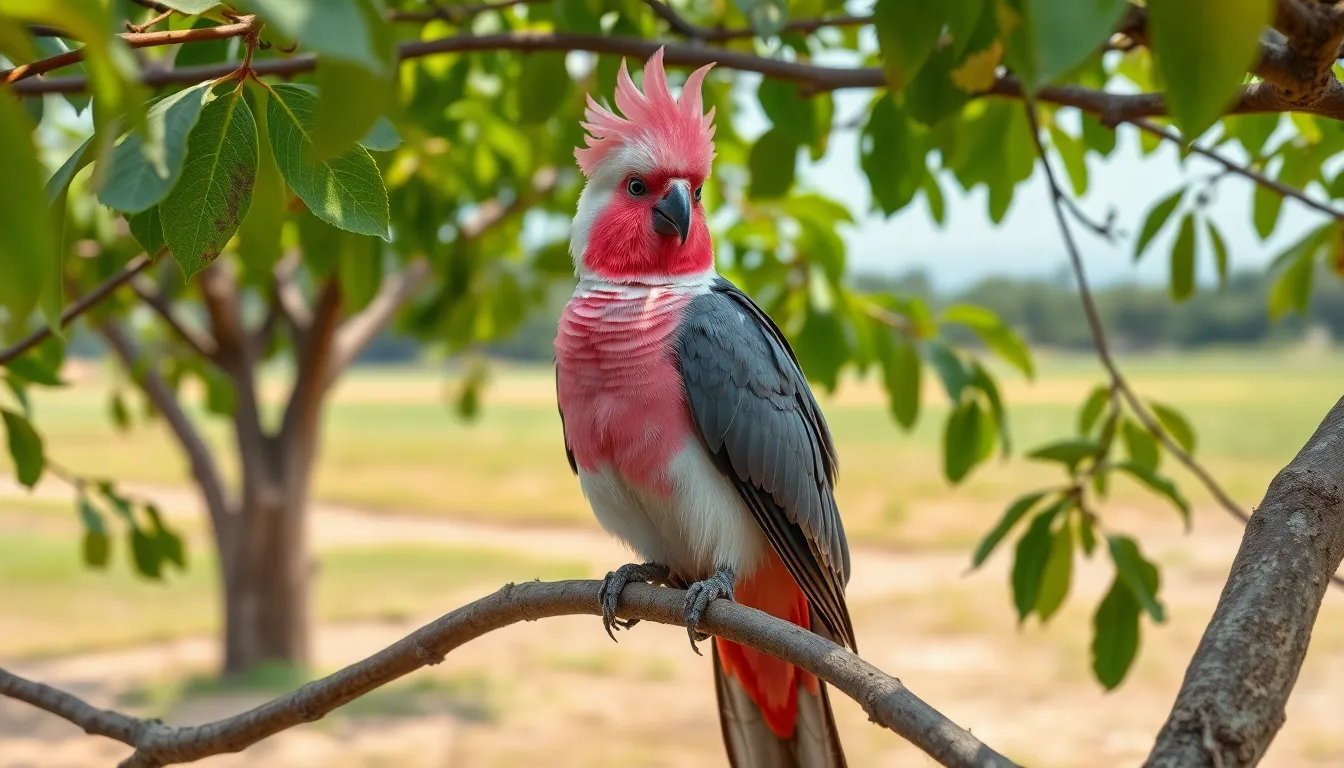
Galahs display complex behavioral patterns that make them fascinating subjects for bird enthusiasts and researchers alike. These intelligent cockatoos exhibit remarkable social awareness and cognitive abilities that distinguish them from many other parrot species.
Social Structure and Flock Dynamics
Galahs form highly organized social groups that range from small family units of 3 to 5 birds to massive flocks containing several hundred individuals. Large congregations typically occur during feeding times and roosting periods, particularly in agricultural areas where food sources are abundant. Family bonds remain strong throughout the year, with breeding pairs maintaining lifelong partnerships that extend beyond the mating season.
Communication within galah flocks operates through a sophisticated system of vocalizations, body language, and crest positioning. Contact calls help maintain group cohesion during flight, while alarm calls alert the entire flock to potential threats. Aggressive displays involve raised crests, spread wings, and harsh screeching sounds that establish dominance hierarchies within the group.
Feeding behaviors demonstrate remarkable coordination as flocks designate sentinel birds to watch for predators while others forage on the ground. Roosting sites accommodate multiple family groups that gather in the same trees each evening, creating temporary communities of 50 to 200 birds. Young galahs learn social protocols by observing adult behaviors and gradually integrate into the flock’s established pecking order.
Intelligence and Problem-Solving Abilities
Galahs demonstrate exceptional cognitive capabilities that rival those of larger parrot species through complex problem solving tasks and tool manipulation. Research studies document their ability to use sticks and leaves as tools to extract insects from tree bark, showing advanced planning and execution skills. Memory retention allows galahs to remember feeding locations, water sources, and safe roosting spots across territories spanning 10 to 15 square kilometers.
Captive galahs master multi step puzzles that require sequential actions to obtain food rewards, indicating abstract thinking abilities. Wild populations adapt their foraging strategies based on seasonal changes, switching between ground feeding and canopy foraging as food availability fluctuates. Innovation appears frequently in urban environments where galahs learn to operate water taps, open garbage bins, and manipulate human made objects for entertainment.
Learning behaviors include vocal mimicry that extends beyond simple sound reproduction to contextual usage of human words and phrases. Young galahs acquire new skills through observation and practice, with successful techniques spreading throughout local populations within 2 to 3 months. Problem solving sessions often become social activities where multiple birds collaborate to overcome obstacles or access difficult food sources.
Diet and Feeding Habits

Galahs demonstrate remarkable dietary flexibility that enables them to thrive across Australia’s diverse landscapes. Their feeding habits adapt to both seasonal availability and environmental conditions throughout their range.
Wild Diet vs. Captivity Nutrition
Wild galahs consume a predominantly seed-based diet consisting of grasses, herbs, and cultivated grains. Native grass seeds form 60-70% of their natural diet, including species like Stipa, Danthonia, and Aristida varieties found across Australian grasslands. Eucalyptus seeds provide additional nutrition, while agricultural crops such as wheat, barley, and sunflower seeds supplement their intake in farming regions.
Fresh vegetation comprises approximately 20-25% of their wild diet, with young shoots, leaves, and flowers offering essential vitamins and minerals. Root vegetables and bulbs become important food sources during drought conditions, demonstrating their adaptability to harsh environments. Insects and larvae contribute protein, particularly during breeding season when females require extra nutrition for egg production.
Captive galah nutrition differs significantly from their wild counterparts’ diet. Commercial pellet feeds provide balanced nutrition but lack the foraging complexity wild birds experience. Fresh fruits like apples, pears, and berries offer natural sugars and vitamins, while vegetables including carrots, broccoli, and leafy greens supply necessary nutrients. Sprouted seeds enhance digestibility and provide live enzymes absent in processed foods.
| Nutritional Component | Wild Diet % | Captive Diet % |
|---|---|---|
| Seeds | 60-70 | 40-50 |
| Fresh vegetation | 20-25 | 30-35 |
| Fruits | 5-10 | 15-20 |
| Protein sources | 5-10 | 5-10 |
Seasonal Feeding Patterns
Spring feeding patterns coincide with abundant grass seed production across Australian landscapes. Galahs focus on newly germinated seeds and fresh plant growth during September through November, timing their breeding season with peak food availability. Nesting pairs increase protein intake through insect consumption, with females requiring additional calcium for eggshell formation.
Summer months create feeding challenges as seed sources dry out and water becomes scarce. Flocks travel greater distances to locate reliable food sources, often concentrating around agricultural areas and urban parks with irrigation. Dawn and dusk feeding becomes more common during extreme heat, with midday rest periods conserved for thermoregulation.
Autumn provides the richest feeding opportunities as mature seeds from native grasses reach peak availability. Large flocks form during March through May, with some groups containing 500-1000 individuals gathering at prime feeding locations. Agricultural harvest periods offer concentrated grain sources, leading to seasonal population shifts toward farming regions.
Winter feeding relies heavily on stored body fat and cached seed locations remembered from previous seasons. Reduced daylight hours compress feeding time to 6-8 hours daily, requiring more efficient foraging strategies. Urban populations supplement their diet with human-provided food sources, though this creates nutritional imbalances and dependency issues.
Galah Birds as Pets
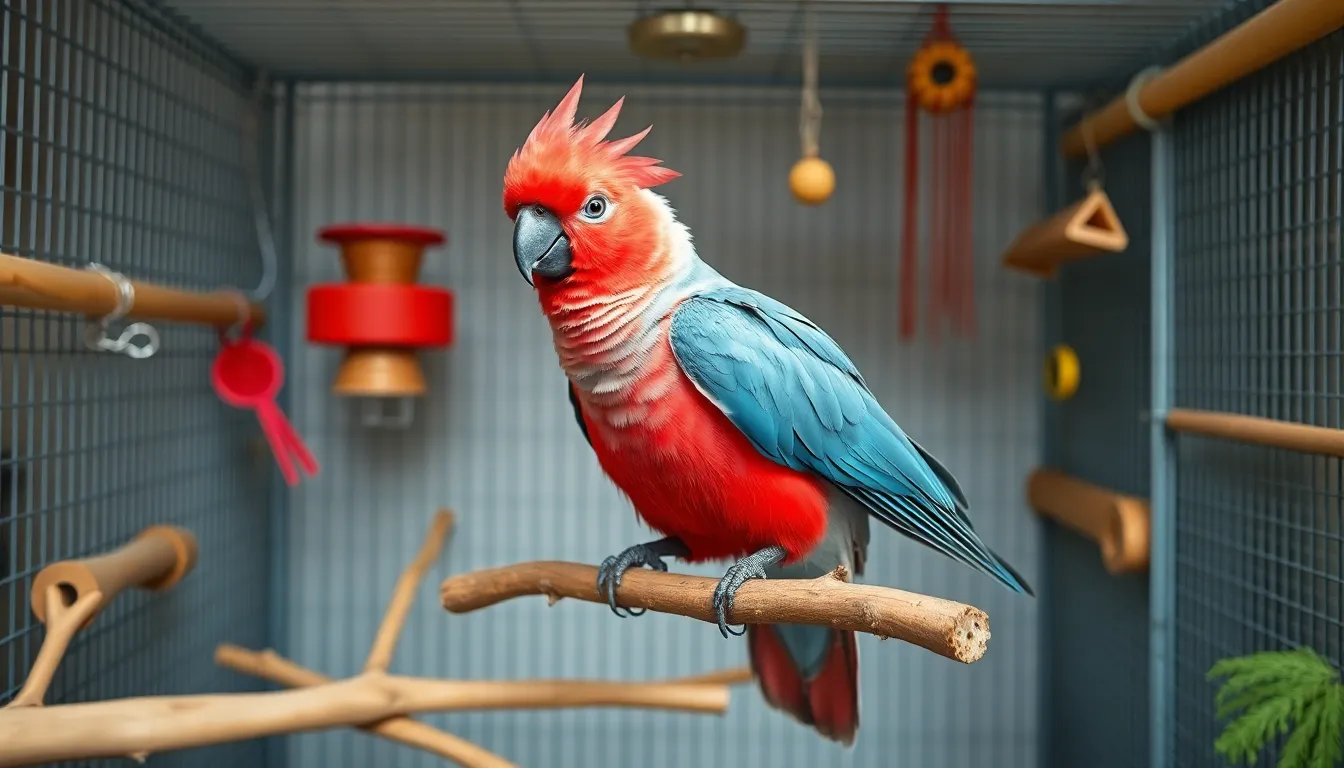
Galah birds make captivating companions for experienced bird owners who understand their complex social and environmental needs. Their intelligence and playful nature require important commitment and specialized care to thrive in captivity.
Housing and Cage Requirements
Galah birds require spacious enclosures measuring at least 6 feet wide, 4 feet deep, and 6 feet tall to accommodate their 24 to 28-inch wingspan. Flight cages work best for these medium-sized cockatoos, allowing them to exercise their natural flying instincts indoors.
Bar spacing between 3/4 inch and 1 inch prevents escapes while ensuring adequate ventilation throughout the enclosure. Stainless steel or powder-coated metal construction provides durability against their strong beaks and prevents toxic metal poisoning.
Multiple perches made from natural branches offer foot exercise and prevent pressure sores on their feet. We recommend eucalyptus, apple, or willow branches with varying diameters between 1 and 2 inches to promote healthy foot development.
Temperature control maintains optimal conditions between 65°F and 80°F, matching their natural Australian climate preferences. Humidity levels around 50% to 60% support their respiratory health and prevent feather problems.
Food and water stations require placement away from perches to maintain cleanliness and prevent contamination. Stainless steel bowls resist bacteria buildup and withstand daily cleaning routines.
Environmental enrichment includes foraging toys, puzzle feeders, and climbing structures that stimulate their problem-solving abilities. Rotating toys weekly prevents boredom and encourages natural behaviors like chewing and manipulation.
Training and Socialization Needs
Galah birds respond well to positive reinforcement training using their favorite treats and consistent daily sessions. Training sessions lasting 10 to 15 minutes twice daily maximize their attention span and learning retention.
Basic commands like step up, step down, and stay form the foundation of galah training programs. These commands establish trust between bird and owner while creating structure in their daily routine.
Socialization begins early in captivity through exposure to different people, sounds, and environments within the home. Young galahs adapt more easily to household routines when introduced gradually to family members and visitors.
Vocal training takes advantage of their natural mimicry abilities, allowing them to learn words, phrases, and household sounds. We observe that galahs learn approximately 20 to 30 words when trained consistently over several months.
Flock calling behavior requires management through scheduled interaction times that satisfy their social needs. Ignoring attention-seeking screams while rewarding quiet behavior helps establish appropriate communication patterns.
Flight training in secure indoor spaces promotes physical fitness and mental stimulation for pet galahs. Recall training ensures their safety during supervised flight sessions within the home environment.
Bite pressure training teaches galahs to control their 350 PSI bite force during interactions with family members. Consistent boundaries and gentle correction prevent aggressive behaviors from developing into permanent habits.
Health and Lifespan
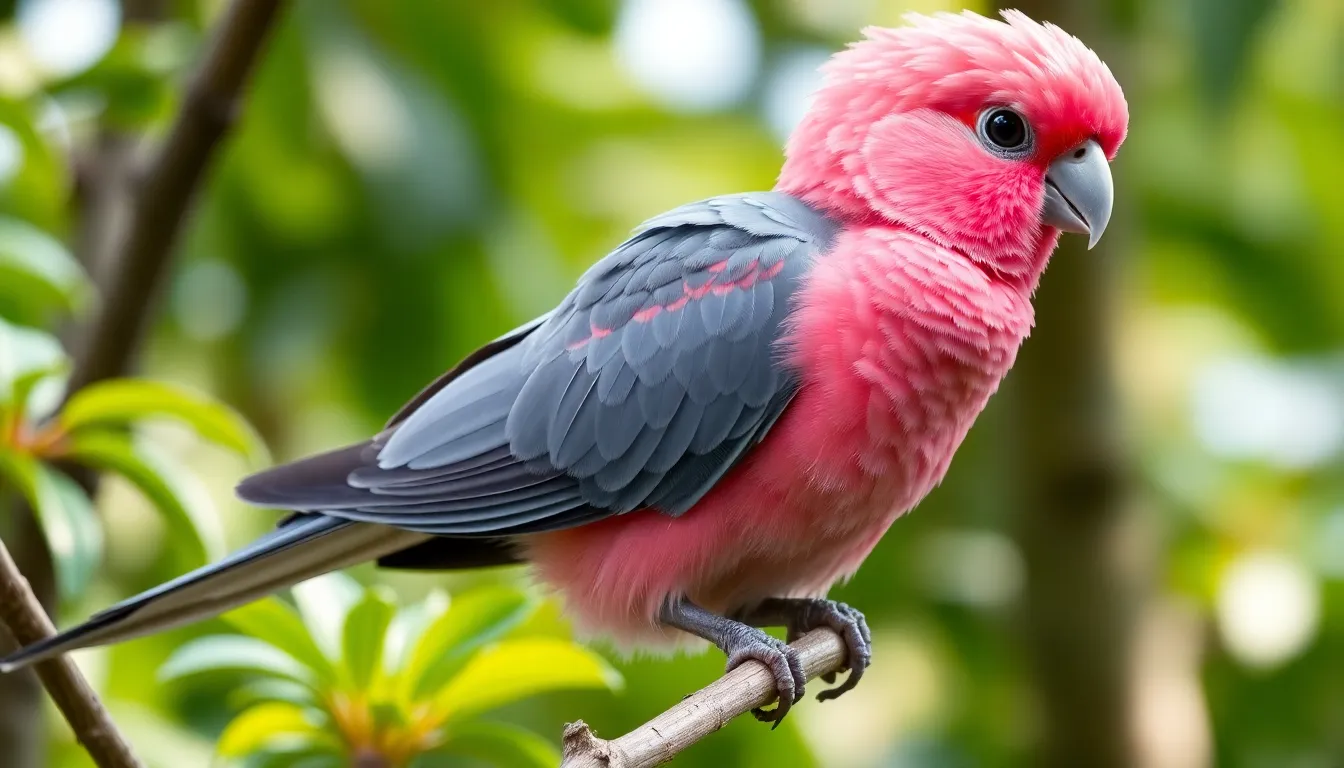
Galahs maintain robust health profiles when provided with proper care and live between 40 to 80 years in captivity. Wild galahs typically experience shorter lifespans of 20 to 40 years due to environmental challenges and predation risks.
Common Health Issues
Respiratory infections represent the most frequent health concern affecting galahs, particularly those caused by bacterial pathogens like Chlamydia psittaci. Symptoms include nasal discharge, difficulty breathing, and reduced activity levels that develop over 3 to 7 days.
Feather plucking disorders affect approximately 15% of captive galahs, stemming from stress, boredom, or nutritional deficiencies. Birds displaying this behavior create bald patches on their chest and wings, requiring immediate behavioral intervention and environmental enrichment.
Psittacine beak and feather disease (PBFD) poses a serious viral threat to galah populations, causing progressive feather loss and beak deformities. Infected birds show symptoms within 6 to 12 months, with mortality rates reaching 100% in severe cases.
Fatty liver disease develops in galahs consuming high-fat seed diets without adequate exercise opportunities. Affected birds exhibit lethargy, difficulty perching, and weight gain exceeding 20% of their normal body weight.
Crop infections occur when galahs consume contaminated food or water, leading to regurgitation and weight loss within 24 to 48 hours. Young birds face higher susceptibility during hand-feeding periods due to improper temperature control.
Veterinary Care Requirements
Annual wellness examinations by avian-certified veterinarians ensure early detection of developing health issues in galahs. These comprehensive checkups include physical assessments, blood work analysis, and fecal parasite screenings.
Blood chemistry panels reveal critical information about liver function, kidney health, and nutritional status through measurements of protein levels, glucose concentrations, and mineral balances. Veterinarians recommend these tests every 12 to 18 months for adult galahs.
Routine beak and nail trimming prevents overgrowth that can interfere with normal feeding and perching behaviors. Professional grooming sessions occur every 6 to 8 weeks, depending on individual growth rates and activity levels.
Emergency veterinary access becomes crucial for galahs showing sudden behavioral changes, breathing difficulties, or trauma injuries. Avian emergencies require immediate attention within 2 to 4 hours to prevent life-threatening complications.
Vaccination protocols for galahs focus on polyomavirus prevention, particularly important for birds in multi-bird households or breeding facilities. Initial vaccination occurs at 6 to 8 weeks of age, followed by annual boosters throughout their lifetime.
Quarantine procedures lasting 30 to 45 days protect existing bird populations when introducing new galahs to households or aviaries. During this period, veterinary monitoring includes multiple health screenings and behavioral assessments.
Conservation Status and Population
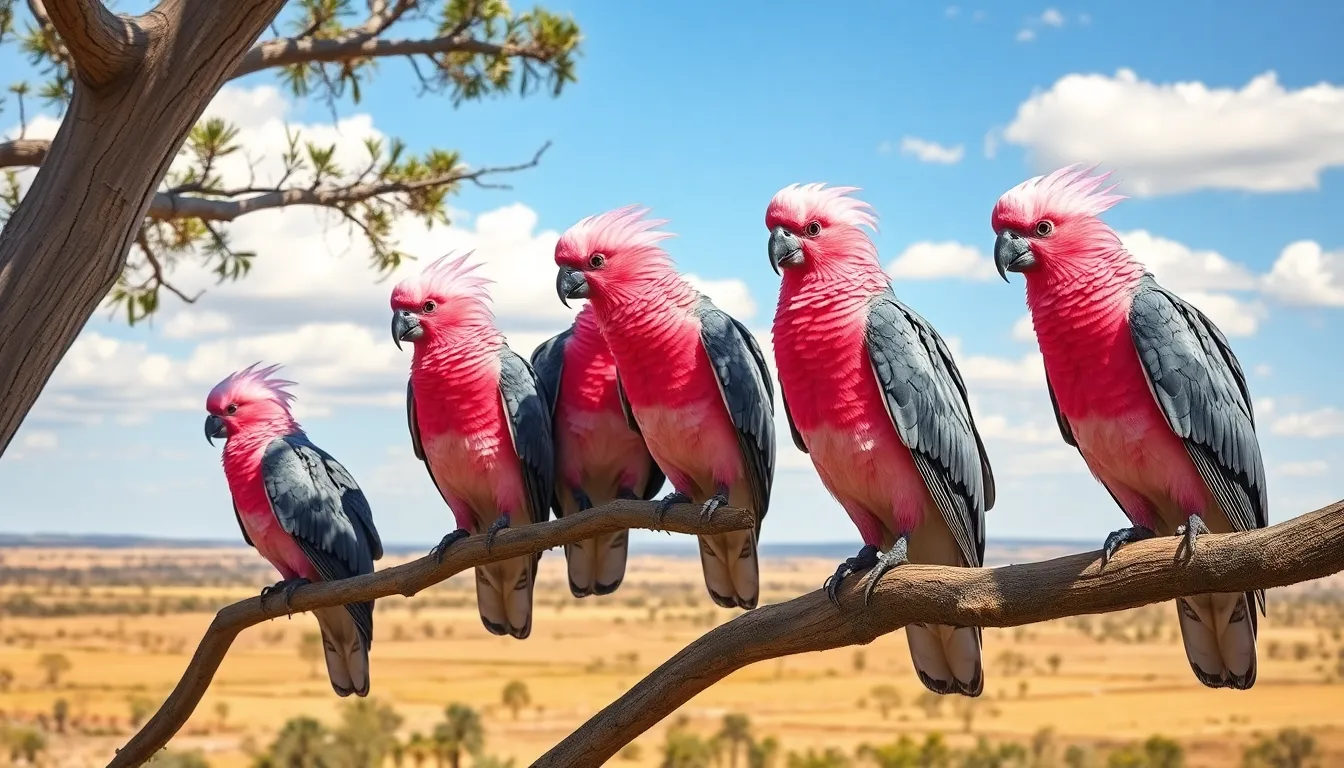
Galahs currently maintain a Least Concern conservation status according to the International Union for Conservation of Nature (IUCN), reflecting their stable population across mainland Australia. Population estimates indicate approximately 5 million to 10 million galahs inhabit the continent, making them one of Australia’s most abundant cockatoo species.
Current Population Trends
Recent surveys demonstrate galah populations have remained stable or increased in many regions over the past 3 decades. Agricultural development has actually benefited these adaptable birds by creating additional food sources through crop cultivation. Urban expansion provides new nesting sites in parks and residential areas where galahs readily establish territories.
Population density varies significantly across their range, with concentrations reaching 50 to 100 birds per square kilometer in optimal habitat zones. Southern Australia supports the highest densities, particularly in regions combining open woodlands with agricultural areas. Northern populations remain sparser due to habitat preferences and seasonal movement patterns.
Threats and Challenges
Climate change poses the primary long-term threat to galah populations through altered rainfall patterns and extreme weather events. Prolonged drought conditions reduce seed availability and force birds to travel greater distances for water sources. Severe heat waves exceeding 45°C (113°F) cause direct mortality and breeding failure in affected regions.
Habitat modification continues affecting local populations even though their adaptability. Land clearing removes essential nesting trees, while intensive agriculture eliminates native seed sources. Urban development fragments flight corridors and creates collision hazards with vehicles and infrastructure.
Disease outbreaks occasionally impact galah communities, with Psittacine Beak and Feather Disease (PBFD) causing localized population declines. Avian influenza and other viral infections spread rapidly through dense flocks during roosting periods.
Conservation Efforts
Wildlife management programs focus on habitat preservation rather than direct population intervention due to galahs’ stable status. Protected areas maintain crucial breeding and foraging sites across their range. Revegetation projects restore native plant communities that provide essential food sources.
Research initiatives monitor population health through annual bird surveys and satellite tracking studies. These programs track movement patterns, breeding success rates, and response to environmental changes. Community science projects engage citizen observers in data collection efforts.
Educational campaigns promote coexistence between humans and galahs in urban environments. These initiatives address property damage concerns while highlighting the ecological benefits these birds provide through seed dispersal and pest control.
| Population Metric | Current Status | Trend |
|---|---|---|
| Total Population | 5-10 million birds | Stable |
| Conservation Status | Least Concern (IUCN) | Unchanged |
| Population Density | 50-100 birds/km² (optimal habitat) | Stable |
| Breeding Success | 70-80% nest success rate | Stable |
| Range Expansion | Urban areas increasing | Positive |
Conclusion
Galahs continue to enchant us with their remarkable adaptability and enduring presence across Australia. These resilient birds have successfully navigated the challenges of modern life while maintaining their wild instincts and social bonds.
Whether we encounter them in their natural habitat or consider them as companions we can appreciate the complexity and intelligence these pink and grey cockatoos bring to our industry. Their stable conservation status offers hope while reminding us of our responsibility to protect their future.
The galah’s story is one of successful coexistence with humans proving that with proper understanding and respect we can share our environments harmoniously. These charismatic birds will undoubtedly continue to capture hearts and minds for generations to come.
Frequently Asked Questions
What is a galah and where are they found?
Galahs (Eolophus roseicapilla) are iconic Australian cockatoos known for their striking pink and grey coloration. They’re found across mainland Australia in diverse environments including woodlands, grasslands, urban parks, and agricultural regions. They’re absent from Tasmania and some offshore islands, preferring areas with scattered eucalyptus trees for nesting and open spaces for foraging.
How big do galahs get and what do they look like?
Galahs are medium-sized cockatoos measuring 14-16 inches in length with a 24-28 inch wingspan. They weigh 10-14 ounces, with females typically lighter. They feature vibrant rose-pink chests and bellies, soft grey backs and wings, and prominent crests used for communication. Males have dark eyes while females have reddish-brown irises.
How long do galahs live?
In captivity with proper care, galahs can live 40-80 years. Wild galahs typically have shorter lifespans of 20-40 years due to environmental challenges like predators, weather extremes, and food scarcity. Their longevity makes them a significant long-term commitment as pets.
What do galahs eat in the wild vs. captivity?
Wild galahs primarily eat native grass seeds, eucalyptus seeds, and agricultural crops, supplemented with fresh vegetation and insects during breeding season. Captive galahs require commercial pellets as their base diet, supplemented with fresh fruits and vegetables. Their feeding patterns adapt seasonally, focusing on abundant grass seeds in spring.
Are galahs intelligent birds?
Yes, galahs exhibit exceptional intelligence and problem-solving abilities that rival larger parrot species. They can use tools, remember locations, adapt foraging strategies, and demonstrate advanced cognitive skills through multi-step puzzles. They also show vocal mimicry abilities and learn through social observation, spreading successful techniques within their flocks.
Do galahs make good pets?
Galahs can be captivating pets for experienced bird owners who can meet their complex social and environmental needs. They require spacious enclosures, environmental enrichment, consistent training, and significant social interaction. Their 40-80 year lifespan, intelligence, and social nature make them demanding but rewarding companions for dedicated owners.
What are common health issues in galahs?
Common galah health problems include respiratory infections, feather plucking disorders, psittacine beak and feather disease (PBFD), fatty liver disease, and crop infections. Regular veterinary care including annual wellness exams, blood work, and proper vaccination protocols are essential for maintaining their health and preventing disease outbreaks.
Are galahs endangered or protected?
Galahs currently hold a “Least Concern” conservation status according to the IUCN, with populations estimated at 5-10 million birds. Recent surveys show stable or increasing populations, aided by agricultural development and urban expansion. However, climate change, habitat modification, and disease outbreaks remain potential long-term threats to their survival.

